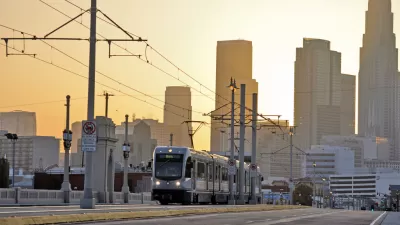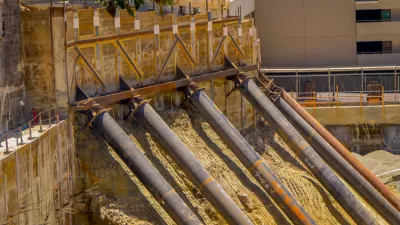There's a new front in the city of L.A.'s ongoing conflict between anti-development forces and efforts to add density at and around transit.

"Fix the City filed a lawsuit last week targeting the city’s Transit Oriented Communities program, which has loosened planning rules for real estate developers who have projects near rail stations and major bus stops," report David Zahniser and Andrew Khouri.
Fix the City’s lawsuit is targeting one development in particular in its larger assault on the Transit Oriented Communities (TOC) program: "a seven-story, 120-unit residential building on Santa Monica Boulevard just west of Century City that relied on the city’s looser planning rules" in winning approval from the city recently. Fix the City has a track record of suing the city's signature land use initiatives, including successfully convincing a judge to overturn the Hollywood Community Plan as approved in 2012. Fix the City has also sued the city's Mobility Plan 2035 and the Exposition Corridor Transit Neighborhood Plan.
The TOC program was set into motion by voters' approval of Measure JJJ in 2016, although the entirety of the reforms implemented by Measure JJJ has produced mixed results over its short lifetime, the number of units taking advantage of the TOC has contributed to a steady stream of new developments around the city's expanding number of transit stations and routes.
- L.A.'s New Transit Oriented Communities Guidelines Are a Boost for Affordable Housing (September 2017)
- L.A.'s Transit-Oriented Communities Program Finds Affordable Housing Success (July 2018)
- Year One of L.A.'s 'Transit Oriented Communities Affordable Housing Incentives Program' (September 2018)
- Report: Ballot Measure Intended to Spur Affordable Development Had the Opposite Effect in L.A. (May 2019)
Interestingly, a May 2019 report cites Measure JJJ's requirements for prevailing wages as the cause of its slow progress. In explaining the lawsuit, however, Fix the City board member Laura Lake "said she voted for Measure JJJ when it was on the ballot in 2016. But she contends that city officials have not made good on the ballot measure’s promise of higher wages for construction workers."
FULL STORY: It’s seen as one of L.A.’s most successful housing programs. A lawsuit seeks to strike it down

Maui's Vacation Rental Debate Turns Ugly
Verbal attacks, misinformation campaigns and fistfights plague a high-stakes debate to convert thousands of vacation rentals into long-term housing.

Planetizen Federal Action Tracker
A weekly monitor of how Trump’s orders and actions are impacting planners and planning in America.

In Urban Planning, AI Prompting Could be the New Design Thinking
Creativity has long been key to great urban design. What if we see AI as our new creative partner?

King County Supportive Housing Program Offers Hope for Unhoused Residents
The county is taking a ‘Housing First’ approach that prioritizes getting people into housing, then offering wraparound supportive services.

Researchers Use AI to Get Clearer Picture of US Housing
Analysts are using artificial intelligence to supercharge their research by allowing them to comb through data faster. Though these AI tools can be error prone, they save time and housing researchers are optimistic about the future.

Making Shared Micromobility More Inclusive
Cities and shared mobility system operators can do more to include people with disabilities in planning and operations, per a new report.
Urban Design for Planners 1: Software Tools
This six-course series explores essential urban design concepts using open source software and equips planners with the tools they need to participate fully in the urban design process.
Planning for Universal Design
Learn the tools for implementing Universal Design in planning regulations.
planning NEXT
Appalachian Highlands Housing Partners
Mpact (founded as Rail~Volution)
City of Camden Redevelopment Agency
City of Astoria
City of Portland
City of Laramie




























